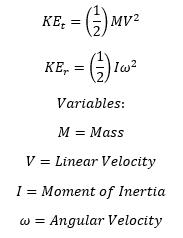By: Robert Munro
This short article will teach you what matters and what doesn’t when it comes to “Rotational Weight”. Since the dawn of lightweight bike stuff, we have been fed the adage that lightweight bike parts will make you go faster and if that thing is spinning it matters a whole lot more than if it isn’t. Unfortunately, this is a gross oversimplification. If you can make it through this quick physics lesson you will know what is worth spending your hard-earned money on and what isn’t.
Let’s review why weight matters on flat land. When you are moving along the road you have kinetic energy (measured in joules if we are keeping it metric). In order to get up to that speed you had to apply more power (Watts) than the road and the wind were exerting against you. That power went into your kinetic energy. If kinetic energy did not exist then you would immediately accelerate up to your desired speed. Once you are up to speed and your kinetic energy is constant, weight doesn’t matter anymore.
There are 2 types of kinetic energy that we care about on the bike, translational and rotational (formula below).
Definition of Translational Kinetic energy in words: Intrinsic energy you and your gear have by moving across the earth. Notice that speed is squared. This is partly why you can accelerate 0-15 mph a lot faster than 15-30 mph. All the mass counts for this part.
Definition of Rotational Kinetic Energy in words: Intrinsic energy the spinning stuff has. You must put energy in just to spin it. Only the spinning mass counts.
When you travel down the road (or trail) your kinetic energy is a summation of both. Therefore:
This also means that spinning stuff counts twice!
Important side note: Translational kinetic energy is a lot larger than rotational.
Now let’s define Moment of Inertia: A quantity expressing a body’s tendency to resist angular (spinning) acceleration. The 2 parts of Moment of inertia are the weight of this object and how far it is from the center of rotation. In fact this distance is squared. See formula below. Therefore the radius becomes significantly more important as it grows as does the mass of the object.
This should be the part of the article where I calculate (and graph) the rotational kinetic energy of all spinning bike components at different speeds. I will spare you that level of boredom. Unless of course I get enough comments on facebook asking for it ;). What I will do is boil it down to make it simple.
Tires, tubes (or sealant), and rims matter;
shoes matter a little;
everything else is negligible.
Finally, let’s talk about going uphill. When going uphill your mass will pull you downward. The relationship is linear. The kicker is that gravitational force does not care if something is spinning. Furthermore, lets remember that kinetic energy only “holds you back” when you accelerate with respect to the ground. If you are slowing down (and hence using your kinetic energy to overcome air resistance and mechanical drag for a time) like you would if you are hitting the bottom of the climb going fast, then having more kinetic energy is actually helpful! Therefore, rotational weight is not more important while climbing.
Whew, you made it! That was a proper Nerd Bomb. But now you are smarter for it. Congratulations! Let me know in the comments if you agree or think I am letting the gel go to my head. Nerd out.











